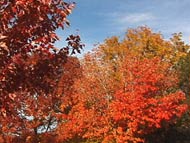Older stories on
Resources News
Links to general resource,
environmental sites
Links to non-profit
environmental/resource groups
Links to environmental/resource news
sources
E-mail Resources
News
Fall Colours a Pollution Source?
Trees are often touted as a tool that can help improve air quality and slow global warning. That's one of the reasons why environmentalists stress the importance of preserving tropical rain forests.
Of course everyone knows that when humans and trees interact, there can be problems. Widespread burning of wood for heating or cooking can cause major air quality problems. Even burning leaves in the fall can become a major problem, which is why the practice is banned in most cities.
Now it also seems that fall leaves can contribute to air quality problems as a result of much more subtle forms of human influence. Recent research suggests that those colourful fall leaves can contribute to smog problems, even if they're just left where they fall.
This fall, scientists from the U.S. National Center for Atmospheric Research (NCAR) are measuring levels of chemicals that are emitted as leaves change color and fall to the ground at a research site in northern Michigan. The chemicals, known as volatile organic compounds (VOCs), can combine with certain types of industrial emissions to create smog, and in some cases can even play a role in global warming.
"VOCs are very important for both regional and global air quality issues," said NCAR's Alex Guenther. VOCs, which are the source of the appealing scents associated with pine needles and cut grass, pose no harm in a natural setting. But they can react with human-generated nitrogen oxides in the presence of sunlight to form ground-level ozone, the major component of smog. The emissions also have an impact on climate by slowing the rate at which greenhouse gases are oxidized in the atmosphere.
The scientists picked Michigan in part because the area's abrupt, heavy frosts are likely to result in high emissions. In contrast, when leaves lose their summer green and wither more gradually, as in the southeastern United States, the result is likely to be lower emissions that linger over a longer period of time.
Preliminary findings show that concentrations of at least two VOCs, methanol and acetaldehyde, more than doubled after a week of colder weather, which signaled the beginning of autumn colors and falling leaves in the region. Funded by the National Science Foundation and the Environmental Protection Agency, the study is intended to help guide anti-pollution efforts by quantifying the chemicals that are given off by plants, as well as by human activities.
"We hope to develop scenarios in which we can have forests and people and cars and power plants and factories, all existing together, without creating toxic levels of pollutants," Guenther said. VOCs play a significant role in the formation of one of the most damaging pollutants: ground-level ozone, which is the major component of what is commonly known as smog. Ozone forms in the presence of sunlight when volatile organic compounds react with nitrogen oxides emitted by cars and industrial plants.
In the past, some of the government's anti-smog efforts have focused on reducing VOCs produced by motor vehicles and other human sources. But that may be of little value, said Guenther, since the bulk of those compounds actually comes from vegetation. A more effective way to fight smog would be to curtail human-generated nitrogen oxide emissions.
Guenther emphasized that plant emissions are harmless in the absence of human-generated nitrogen oxides. In fact, trees and other types of vegetation can even benefit air quality by absorbing ozone and some other types of pollutants, as well as giving off scents that people find pleasing. But, Guenther explained: "In an atmosphere modified by people, plant emissions do contribute to pollution."
